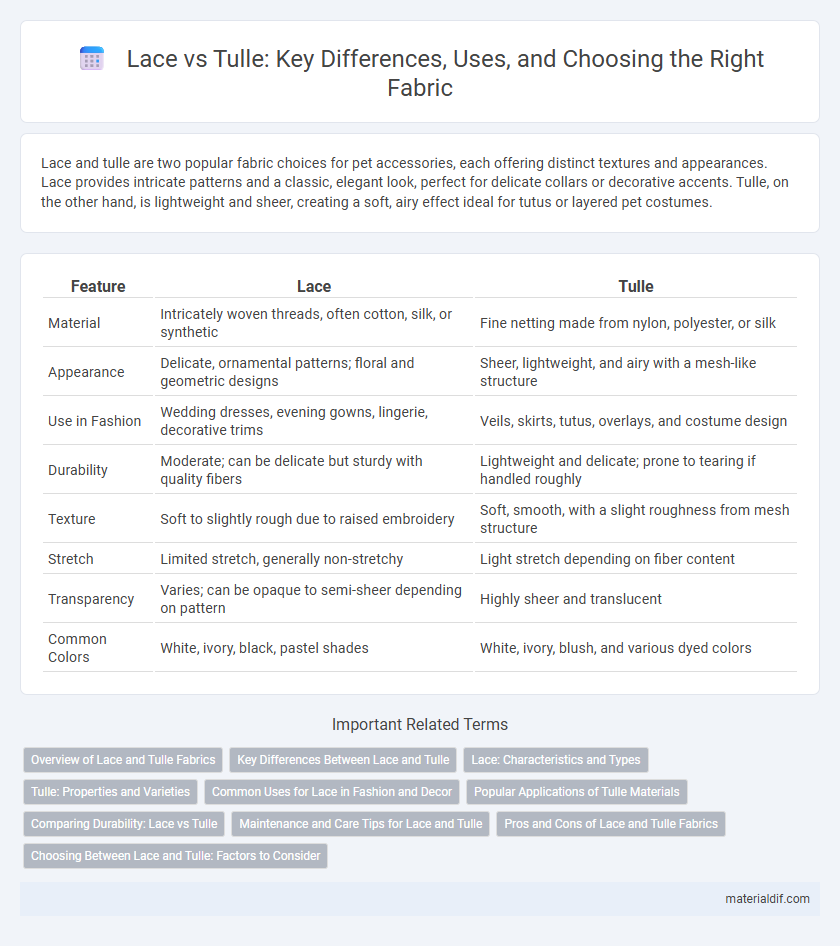Lace and tulle are two popular fabric choices for pet accessories, each offering distinct textures and appearances. Lace provides intricate patterns and a classic, elegant look, perfect for delicate collars or decorative accents. Tulle, on the other hand, is lightweight and sheer, creating a soft, airy effect ideal for tutus or layered pet costumes.
Table of Comparison
| Feature | Lace | Tulle |
|---|---|---|
| Material | Intricately woven threads, often cotton, silk, or synthetic | Fine netting made from nylon, polyester, or silk |
| Appearance | Delicate, ornamental patterns; floral and geometric designs | Sheer, lightweight, and airy with a mesh-like structure |
| Use in Fashion | Wedding dresses, evening gowns, lingerie, decorative trims | Veils, skirts, tutus, overlays, and costume design |
| Durability | Moderate; can be delicate but sturdy with quality fibers | Lightweight and delicate; prone to tearing if handled roughly |
| Texture | Soft to slightly rough due to raised embroidery | Soft, smooth, with a slight roughness from mesh structure |
| Stretch | Limited stretch, generally non-stretchy | Light stretch depending on fiber content |
| Transparency | Varies; can be opaque to semi-sheer depending on pattern | Highly sheer and translucent |
| Common Colors | White, ivory, black, pastel shades | White, ivory, blush, and various dyed colors |
Overview of Lace and Tulle Fabrics
Lace is a delicate fabric characterized by intricate, openwork patterns created through looping or twisting threads, often made from cotton, silk, or synthetic fibers. Tulle is a lightweight, fine netting fabric composed of nylon, silk, or rayon, known for its sheer appearance and stiff texture that provides volume. Both fabrics are popular in bridal and formal wear, with lace offering decorative elegance and tulle contributing structure and airy softness.
Key Differences Between Lace and Tulle
Lace is a delicate fabric characterized by intricate patterns created through looping or knotting threads, often made from cotton, silk, or synthetic fibers, while tulle is a lightweight, net-like fabric made from nylon, polyester, or silk, known for its fine mesh and stiffness. Lace provides an ornate and textured appearance with detailed floral or geometric designs, typically used in bridal gowns and decorative overlays, whereas tulle offers volume and sheerness, commonly used in veils, tutus, and layered skirts. The key differences lie in lace's decorative complexity versus tulle's airy structure and structural support.
Lace: Characteristics and Types
Lace is an intricate fabric known for its delicate openwork patterns created through looping, braiding, or twisting threads, often made from cotton, silk, or synthetic fibers. Common types include Chantilly, recognized for its fine floral designs and light feel; Alencon, noted for its needlepoint details and raised cording; and Guipure, distinguished by its heavy, embroidered motifs connected by bars rather than netting. Valued for its elegance and texture, lace is widely used in bridal gowns, evening wear, and luxury accessories.
Tulle: Properties and Varieties
Tulle is a lightweight, fine netting fabric made from nylon, polyester, or silk, characterized by its sheer appearance and stiff texture. It comes in various types such as soft, stiff, stretch, and flocked tulle, each suited for different applications like bridal veils, ballet tutus, and decorative overlays. Known for its durability and ability to hold shape, tulle is favored for creating volume and delicate, airy designs in fashion and event decor.
Common Uses for Lace in Fashion and Decor
Lace is extensively used in bridal wear, evening gowns, and lingerie due to its intricate patterns and elegant texture. Home decor often features lace for tablecloths, curtains, and decorative pillow covers, adding a vintage or romantic touch. Unlike the sheer, netted appearance of tulle, lace provides both visual interest and subtle opacity, making it ideal for detailed embellishments and sophisticated designs.
Popular Applications of Tulle Materials
Tulle fabric is widely used in wedding gowns, ballet tutus, and decorative veils due to its lightweight, sheer, and flexible nature. Its net-like structure allows for volume without weight, making it ideal for layering in evening wear and costume design. Tulle also serves as a popular choice for event decorations, including table skirts and drapery, because of its elegant and airy appearance.
Comparing Durability: Lace vs Tulle
Lace is generally more durable than tulle due to its thicker, tightly woven threads and intricate patterns that can withstand wear and tear better. Tulle, made from fine netting, is delicate and prone to snagging or tearing under stress, making it less suitable for heavy-use garments. When choosing fabric for long-lasting apparel, lace offers superior strength and resilience compared to the fragile, airy structure of tulle.
Maintenance and Care Tips for Lace and Tulle
Lace fabric requires gentle hand washing with mild detergent to preserve its intricate patterns and prevent fraying. Tulle, being more delicate and prone to snagging, should be cleaned with cold water and minimal agitation, preferably by hand or on a gentle machine cycle. Both fabrics benefit from air drying flat to maintain shape and avoid direct sunlight, which can weaken fibers and cause discoloration.
Pros and Cons of Lace and Tulle Fabrics
Lace fabric offers intricate patterns and elegant textures, making it ideal for formal wear and bridal gowns, but it can be delicate and prone to snagging or tearing. Tulle is lightweight and provides volume with a sheer, airy appearance, perfect for skirts and veils, though it may lack durability and is less detailed than lace. Choosing between lace and tulle depends on the desired garment structure, aesthetic intricacy, and durability requirements.
Choosing Between Lace and Tulle: Factors to Consider
Choosing between lace and tulle depends on the desired texture, appearance, and durability of the fabric. Lace offers intricate patterns and a vintage, elegant look suitable for bridal gowns and formal wear, while tulle provides lightweight, sheer volume ideal for skirts, veils, and overlays. Consider factors like fabric weight, breathability, and the garment's intended use to determine whether lace's ornate detail or tulle's airy quality best meets your design needs.
Lace vs Tulle Infographic

 materialdif.com
materialdif.com